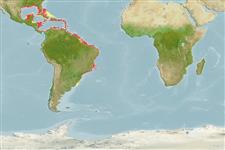Environment: milieu / climate zone / depth range / distribution range
Ecología
marino; agua dulce; salobre demersal; anfidromo (Ref. 46888). Tropical; 25°C - 30°C (Ref. 97140); 32°N -
Northwest to western Central Atlantic: Bermuda, Bahamas, South Carolina and northern Gulf of Mexico in USA to southeastern Brazil.
Tamaño / Peso / Age
Maturity: Lm ? range ? - ? cm
Max length : 25.0 cm TL macho / no sexado; (Ref. 7251); common length : 12.5 cm TL macho / no sexado; (Ref. 12193)
Espinas dorsales (total): 7; Radios blandos dorsales (total): 9; Espinas anales 0; Radios blandos anales: 9
Adults are found on shallow, muddy or sandy bottoms (Ref. 13628). They appear to prefer estuarine freshwater tributaries, occurring in waters with a salinity range of 0 to 19 ppt (Ref. 7251), or up to 36.6 in some cases (Ref. 97140). Feed on dipteran larvae and pupae (especially the juveniles); crustaceans like crabs and shrimps; and small fishes. The diet changes with sexual maturity and season. Gonadal development takes place during the dry season. Average size at maturity is 5.7 mm for males and 4.3 mm for females (Ref. 35237).
Life cycle and mating behavior
Madurez | Reproducción | Puesta | Huevos | Fecundidad | Larva
Robins, C.R. and G.C. Ray, 1986. A field guide to Atlantic coast fishes of North America. Houghton Mifflin Company, Boston, U.S.A. 354 p. (Ref. 7251)
IUCN Red List Status (Ref. 130435)
Threat to humans
Harmless
Human uses
Más información
ColaboradoresImágenesStamps, Coins Misc.SonidosCiguateraVelocidadTipo de nataciónSuperficie branquialOtolitosCerebrosVisión
Herramientas
Special reports
Download XML
Fuentes de Internet
Estimates based on models
Preferred temperature (Ref.
123201): 23.4 - 28.1, mean 27.2 °C (based on 808 cells).
Phylogenetic diversity index (Ref.
82804): PD
50 = 0.5000 [Uniqueness, from 0.5 = low to 2.0 = high].
Nivel trófico (Ref.
69278): 3.7 ±0.4 se; based on diet studies.
Resiliencia (Ref.
120179): Medio, población duplicada en un tiempo mínimo de 1.4-4.4 años (Preliminary K or Fecundity.).
Fishing Vulnerability (Ref.
59153): Low vulnerability (15 of 100).
